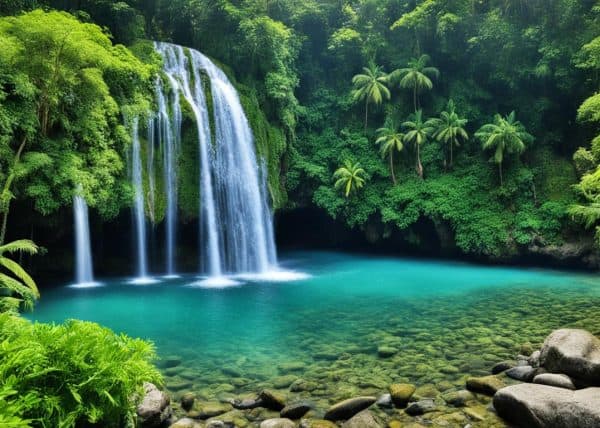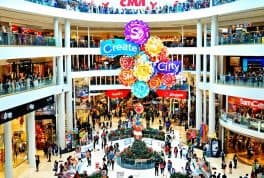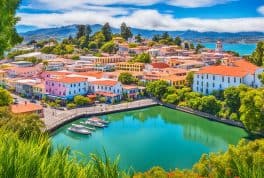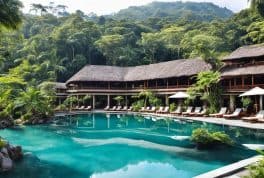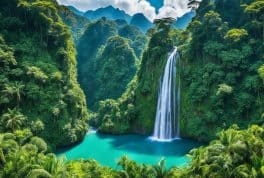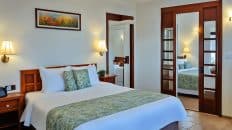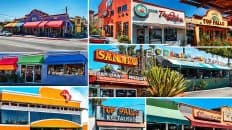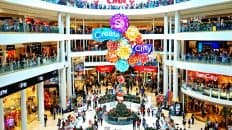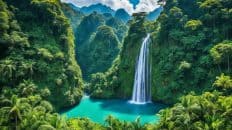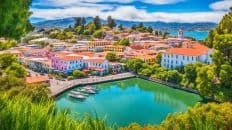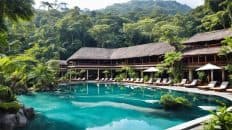San Pablo City
San Pablo City, Laguna, known as the 'City of Seven Lakes,' is a picturesque destination in Southern Luzon, Philippines. Famous for its stunning lakes, such as Sampaloc Lake, rich cultural heritage, and the delightful Buko Pie, it offers a perfect blend of natural beauty and local charm. This serene city is ideal for those seeking a peaceful retreat amidst lush landscapes and a taste of vibrant Filipino traditions.
Top 10 Things to See in San Pablo Laguna
- The Seven Lakes of San Pablo: Each with its unique charm, these lakes – Sampaloc, Palakpakin, Bunot, Mohicap, Yambo, Pandin, and Calibato – offer breathtaking views and serene environments. They are perfect for picnics, boat rides, and nature photography.
- Sampaloc Lake: The largest of the seven lakes, Sampaloc Lake is encircled by a road, making it accessible for jogging, biking, and leisurely walks. The lakefront is dotted with cafes and restaurants where visitors can enjoy the scenic view.
- Pandin Lake: Known for its pristine and untouched beauty, Pandin Lake is ideal for an immersive nature experience. Bamboo rafting across this lake is a popular activity, offering a peaceful escape amidst lush greenery.
- Villa Escudero Plantations and Resort: This coconut plantation and resort offer a unique glimpse into the Philippines' rural culture and history. The highlight is its waterfall restaurant where guests can dine while soaking their feet in the shallow running water.
- Bato Springs Resort: A refreshing getaway, Bato Springs offers clear, spring-fed pools set against a backdrop of lush vegetation and rugged cliffs, making it a perfect spot for relaxation and family outings.
- San Pablo Cathedral: A historical landmark in the city, the cathedral is known for its architectural beauty and religious significance. It's a peaceful sanctuary and a testament to San Pablo's rich historical heritage.
- Doña Leonila Park: This park is a great spot for families and individuals looking to enjoy leisurely activities in a well-maintained green space. It's perfect for picnics, casual strolls, and relaxation.
- Buko Pie Shops: No visit to San Pablo is complete without trying the famous Buko Pie, a sweet and creamy dessert made from young coconut. Numerous shops around the city offer this delicious local specialty.
- Palakpakin Lake: Particularly known among fishing enthusiasts, this lake provides a serene environment for angling and relaxation. It's less crowded compared to Sampaloc Lake, offering a more laid-back atmosphere.
- Mount Banahaw: While technically not in San Pablo, this mystical mountain is close enough to merit a visit. Known as a holy mountain, it offers hiking trails that lead to scenic spots and is a popular destination for nature lovers and spiritual seekers.
Guides and Tours
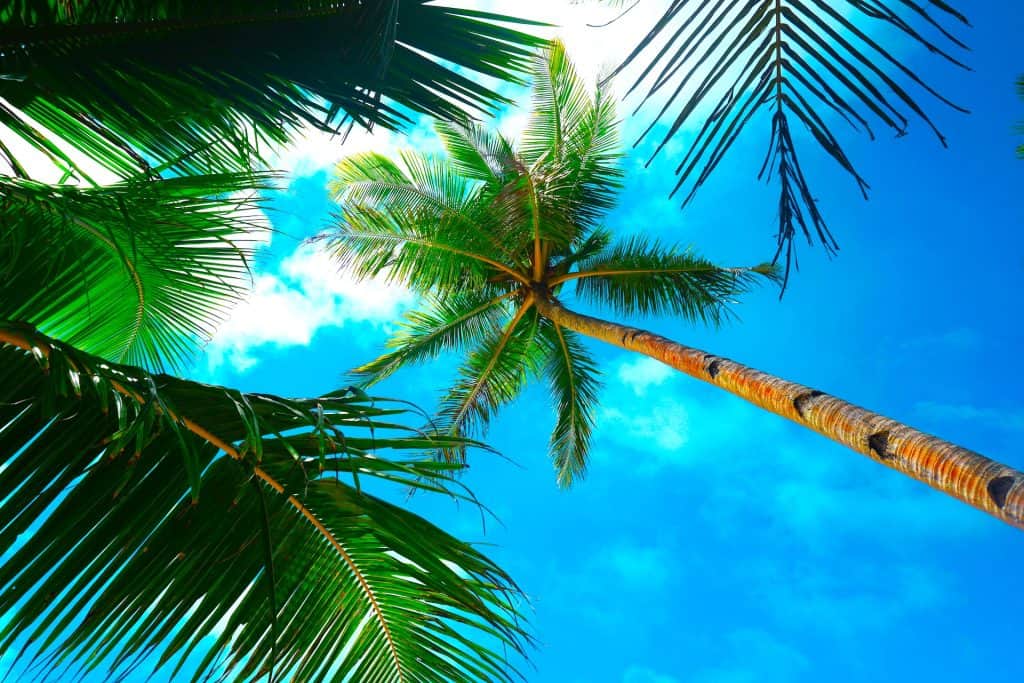
Top 10 Questions and Answers about San Pablo Laguna
- What is San Pablo, Laguna known for?
- San Pablo is famous for its Seven Lakes (Sampaloc, Palakpakin, Bunot, Mohicap, Yambo, Pandin, and Calibato), each offering unique natural beauty. It's also known for its rich cultural heritage and delicious Buko Pie.
- Where is San Pablo, Laguna located?
- San Pablo City is located in the province of Laguna, in the Calabarzon region of the Philippines. It's situated in the southern part of Luzon Island.
- How do I get to San Pablo, Laguna?
- San Pablo is accessible by road from Manila. It's about a 2-3 hour drive via the South Luzon Expressway (SLEX) and the Pan-Philippine Highway.
- What are the best tourist spots in San Pablo, Laguna?
- The Seven Lakes, especially Sampaloc Lake and Pandin Lake, are must-visit spots. Other attractions include Villa Escudero Plantations and Resort, Bato Springs Resort, and the historical San Pablo Cathedral.
- Can I go swimming in the Seven Lakes of San Pablo?
- Swimming is allowed in some of the Seven Lakes, such as Pandin Lake. However, it's important to check local guidelines and ensure safety measures are followed.
- What is the best time to visit San Pablo, Laguna?
- The best time is during the dry season from December to May, when the weather is more conducive to outdoor activities and exploring the lakes.
- What local food should I try in San Pablo, Laguna?
- Definitely try the Buko Pie, a local dessert made from young coconut. Other local dishes to try include fresh seafood and traditional Filipino cuisine at local eateries.
- Are there accommodations available in San Pablo, Laguna?
- Yes, there are various accommodations ranging from resorts and hotels to budget-friendly inns and guesthouses, catering to different preferences and budgets.
- Is San Pablo, Laguna suitable for family trips?
- Absolutely, San Pablo is great for families. With its natural attractions, parks, and resorts, there are plenty of activities suitable for all ages.
- What are some cultural activities or festivals in San Pablo, Laguna?
- San Pablo hosts several festivals, including the Coco Festival in January, celebrating the coconut industry. The city also features cultural events, showcasing local music, dance, and crafts.
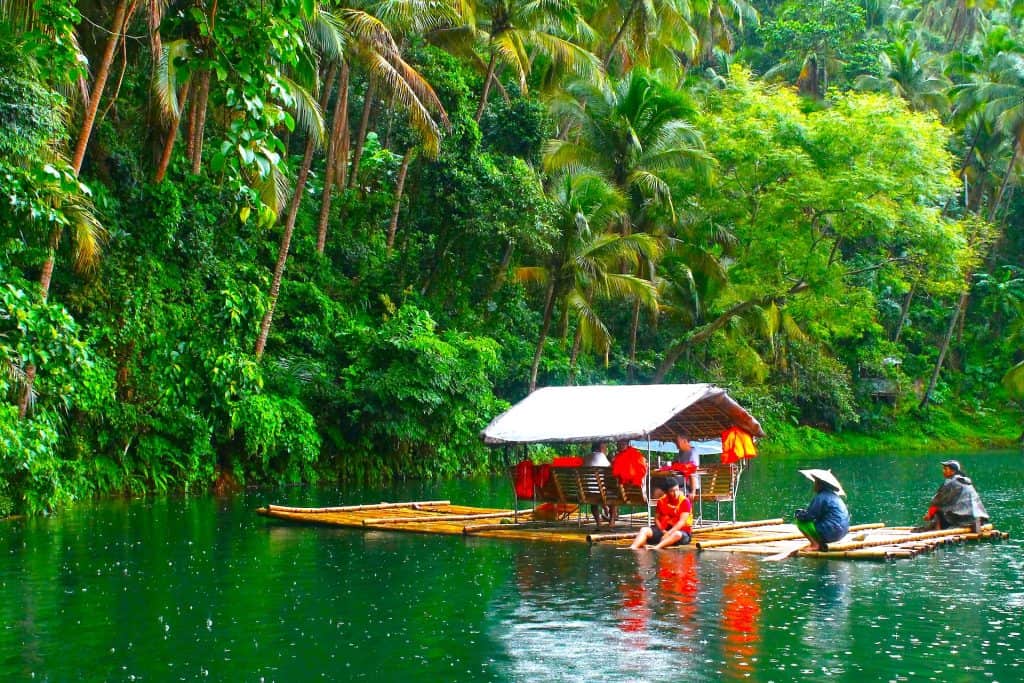
Why you should visit San Pablo Laguna
Discovering the Hidden Gem: San Pablo City, Laguna
Introduction to San Pablo, Laguna
Nestled in the southern part of Luzon, Philippines, San Pablo City, Laguna, emerges as a hidden gem that offers an exquisite blend of natural beauty, cultural richness, and a serene atmosphere. Known for its Seven Lakes and charming cityscape, San Pablo, Laguna is an ideal destination for travelers seeking a blend of adventure, relaxation, and cultural immersion.
The Allure of the Seven Lakes
A visit to San Pablo is incomplete without experiencing the magnificence of its Seven Lakes – each lake offering a unique charm and story. From the largest, Sampaloc Lake, encircled by a thriving community, to the hidden tranquility of Pandin Lake, these natural wonders are perfect for leisurely activities such as boating, fishing, or simply enjoying the picturesque views.
Sampaloc Lake: The Heart of San Pablo
Sampaloc Lake, the most accessible and developed of the Seven Lakes, is a hub of activity in San Pablo City. Visitors can enjoy a scenic walk around the lake, indulge in local cuisine at lakeside restaurants, or watch a stunning sunset that paints the sky in hues of orange and pink. It's not just a lake; it's a vibrant community where locals and visitors come together to enjoy the natural beauty of San Pablo, Laguna.
Pandin Lake: A Secluded Paradise
For those seeking tranquility, Pandin Lake offers a serene escape. This secluded lake, surrounded by lush greenery, is accessible only by a short hike, adding to its untouched allure. A bamboo raft ride across Pandin Lake is a must-do, providing a peaceful experience amidst the natural beauty of San Pablo.
Cultural Richness in San Pablo City
San Pablo, Laguna, is not just about natural landscapes; it's a city steeped in history and culture. The San Pablo Cathedral, a historical landmark, stands as a testament to the city’s colonial past and religious heritage. Exploring the city streets, visitors can find a blend of old-world charm and modern vibrancy, with heritage houses alongside contemporary establishments.
Festivals and Local Traditions
The city's cultural tapestry is vividly displayed in its festivals. The Coco Festival, celebrated in January, is a colorful and lively event that pays homage to the city’s coconut industry. Through dance, music, and art, the festival showcases the rich cultural heritage of San Pablo, Laguna.
Culinary Delights in San Pablo
A journey through San Pablo is also a culinary adventure. The city is famed for its Buko Pie, a deliciously sweet and creamy dessert made from fresh coconut. Local restaurants and eateries offer a range of Filipino dishes, where the flavors of Laguna come to life. Dining in San Pablo is not just about food; it’s about experiencing the local culture and traditions.
The Buko Pie Experience
No visit to San Pablo, Laguna, is complete without trying the Buko Pie. This local delicacy, known for its flaky crust and rich filling, can be found in various bakeries throughout the city. It’s a taste of San Pablo’s local charm, wrapped in a pie.
Outdoor Adventures and Activities
For adventure seekers, San Pablo offers a range of outdoor activities. The city’s landscape is ideal for hiking, biking, and bird watching. The nearby Mount Banahaw provides challenging trails for hikers and nature enthusiasts. Whether you’re looking for a leisurely stroll or an adrenaline-filled adventure, San Pablo, Laguna, caters to all tastes.
Biking and Hiking Trails
The area around the Seven Lakes offers numerous trails for biking and hiking enthusiasts. These trails not only provide a great workout but also offer stunning views of the city and its natural surroundings. It’s an experience that combines fitness with the sheer beauty of San Pablo.
Eco-Tourism and Sustainability
San Pablo City is committed to eco-tourism and sustainable practices. The preservation of its lakes and natural environment is a top priority. By visiting San Pablo, tourists contribute to the city’s efforts in maintaining its natural beauty and supporting sustainable tourism.
A Model for Sustainable Tourism
San Pablo’s approach to tourism is a model for sustainable practices. The city promotes responsible tourism that respects and preserves the environment. By choosing eco-friendly activities and accommodations, visitors play a part in protecting the natural beauty of San Pablo, Laguna.
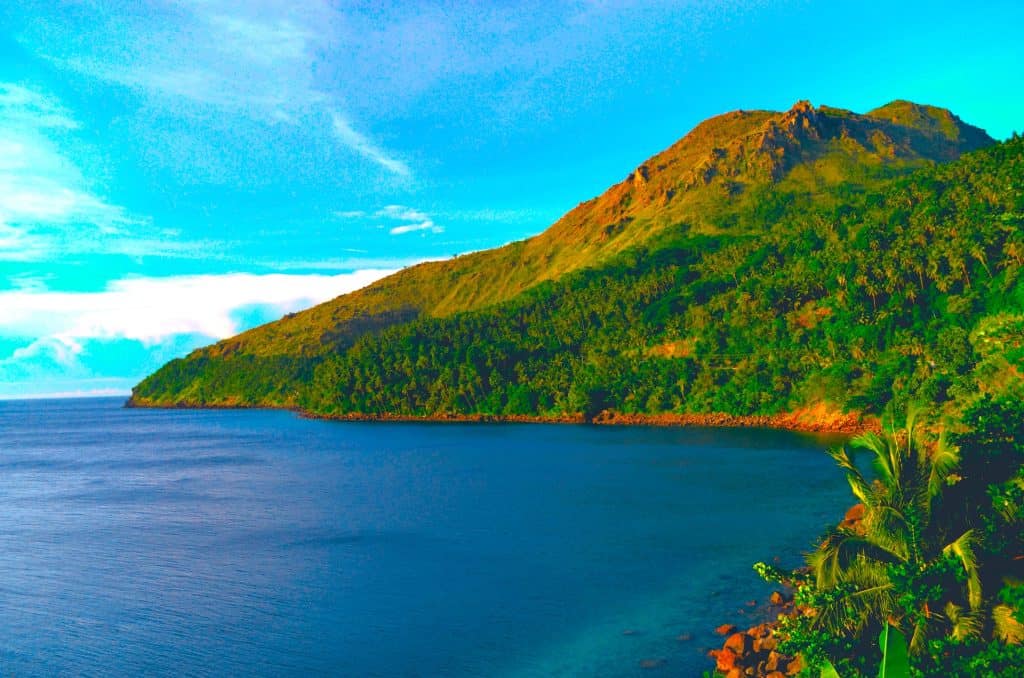
Getting to San Pablo Laguna
Getting to San Pablo, Laguna, is a straightforward journey, especially if you're starting from Metro Manila or nearby regions. Here's a detailed description of the various ways you can reach this picturesque city:
By Private Vehicle:
- From Metro Manila: The most common route is via the South Luzon Expressway (SLEX). You'll drive southbound, passing through cities like Muntinlupa, Santa Rosa, and Calamba.
- Exit at Sto. Tomas, Batangas: After the Calamba toll plaza, you should take the Sto. Tomas exit to head towards the Maharlika Highway (Pan-Philippine Highway/AH26).
- Drive Towards Laguna: Continue on the Maharlika Highway, passing through towns like Alaminos and San Pablo. The drive usually takes around 2 to 3 hours, depending on traffic conditions.
By Public Transportation:
- Bus from Metro Manila: Several bus lines operate from different parts of Metro Manila to Laguna. Look for buses heading to Lucena or those specifically going to San Pablo. Major bus terminals are located in Cubao, Buendia, and Alabang.
- Travel Time: The journey by bus can take approximately 3 to 4 hours, depending on traffic and the specific departure point in Manila.
- Drop-off Points: Buses usually drop passengers off at the San Pablo town proper, from where you can take local transportation to your specific destination in the city.
By Commuter Train and Jeepney (Alternative Route):
- Train to Calamba: Take a Philippine National Railways (PNR) train from Manila to Calamba, Laguna.
- Jeepney to San Pablo: From Calamba, catch a jeepney or a bus going to San Pablo. This route might be longer but offers a glimpse into local commuter life.
Tips for the Journey:
- Traffic Considerations: Traffic can be heavy, especially during peak hours and weekends, so plan your departure time accordingly.
- Navigation Apps: Utilize GPS navigation apps like Waze or Google Maps for real-time traffic updates and route options.
- Local Transport: Once in San Pablo, tricycles and jeepneys are the most common forms of local transportation for getting around the city.
- Travel Light: If you're using public transport, it's best to travel light for convenience.
Getting to San Pablo, Laguna, offers a pleasant journey through some of Luzon’s scenic routes. Whether you’re driving or using public transport, the trip is part of the experience, setting the stage for the natural beauty and serene atmosphere that awaits in San Pablo.
San Pablo Laguna Facts
1: Introduction to San Pablo, Laguna
Nestled in the southern portion of Luzon lies the picturesque city of San Pablo, a component city in Laguna Province that offers a unique blend of cultural richness, natural beauty, and economic vibrancy. Often referred to as the "City of Seven Lakes," San Pablo is not just a mere dot in the vast landscape of the Philippines; it is a city that resonates with history, culture, and a promise of a serene yet dynamic lifestyle.
San Pablo Laguna, with its cool climate owing to its elevation and proximity to prominent mountains like Mount Banahaw and Mount Makiling, has become an attractive destination for both locals and tourists. The city's land area, spanning approximately 197.56 square kilometers, cradles a population diverse in culture and heritage, making it a melting pot of traditions and modernity located in the heart of Southern Luzon.
The history of San Pablo dates back to its early years as a part of the majestic Laguna Province. It stands out as a city rich in historical significance, with its roots deeply embedded in the pre-colonial era of the Philippines. The city's name, San Pablo, is a tribute to its patron saint, Saint Paul the First Hermit, embodying the deep religious and cultural values that have shaped the city and its people over centuries.
San Pablo City's transformation into a bustling center did not occur overnight. It evolved from being a town of Laguna to a component city, officially becoming San Pablo City on May 7, 1940. This transition marked a significant development in its history, underscoring its importance in the region's economic and cultural landscape.
The city's governance, with the San Pablo City Hall at its center, reflects its commitment to serving its constituents through proactive leadership and community-driven initiatives. San Buenaventura, being served as one of three mountains the city's notable barangays, exemplifies the local government's dedication to maintaining peace and order, fostering community development, and upholding the welfare of its residents.
San Pablo's topography is a marvel of nature, dominated by the famous Seven Lakes, each with its own unique charm and story. These lakes - Sampaloc Lake, Palakpakin Lake, Bunot Lake, Mohicap Lake, Yambo Lake, Pandin Lake, and Calibato Lake - are not just bodies of water; they are symbols of San Pablo's natural beauty and ecological significance. They provide attractions for visitors and locals alike, offering a serene escape from the hustle and bustle of city life.
The city's tourism industry thrives mainly because of these natural wonders. Lake Pandin, in particular, is a haven for those seeking a tranquil experience, with its lush greenery and pristine waters. Meanwhile, Sampaloc Lake, the largest of the seven, is a favorite spot for picnics, jogging, and leisurely walks, especially with the backdrop of the sun setting against the calm waters.
San Pablo's cool climate is a result of its geographical location, located sandwiched between two of the country's most famous mountains. Mount Banahaw, considered a holy mountain by many locals, and Mount Makiling, a legendary mountain known for its rich biodiversity and waterfalls, contribute to the city's cool and invigorating air, making it a perfect retreat from the tropical heat of the southeast Philippines.
The city's total population reflects a diverse mix of ethnicities and cultures, a testament to its role as a melting pot in Southern Luzon. The inhabitants of San Pablo are known for their warmth and hospitality, welcoming visitors with open arms and a friendly smile. This characteristic warmth extends to the city's numerous festivals and cultural events, where the rich heritage and vibrant history of San Pablo are celebrated with great enthusiasm and pride.
Economically, San Pablo has seen significant growth and development over the years. Its strategic location in the southern portion of Luzon makes it an ideal hub for businesses and industries seeking opportunities in the region. The city's economy is bolstered by its rich agricultural lands, producing many forest-based products and serving as a vital source of livelihood for many of its residents.
The cityscape of San Pablo is a harmonious blend of the old and the new. Ancient churches stand alongside modern buildings, narrow streets open up to sprawling plazas, and traditional markets coexist with contemporary shopping centers like SM San Pablo. This juxtaposition of the historical and the modern is a defining characteristic of San Pablo, offering a glimpse into its rich past while embracing the promises of the future.
San Pablo's commitment to preserving its natural environment is evident in its efforts to maintain clean air and waterfalls protect its natural resources. The city government actively promotes environmental awareness and conservation, ensuring that the beauty of San Pablo is preserved for future generations.
In conclusion, San Pablo, Laguna is not just a city; it is a living testament to the enduring spirit of the Filipino people. Its natural beauty, cool climate, rich history, and vibrant culture make it a gem in the heart of Southern Luzon. Whether you are a resident, a visitor, or someone seeking opportunities for growth and exploration, San Pablo opens its doors to a world of possibilities, inviting everyone to experience its unique charm and boundless potential.
2: The Natural Beauty and Climate of San Pablo
San Pablo, Laguna, often hailed as a jewel in the crown of Southern Luzon, is a city that truly embodies the essence of natural beauty. It is a locale where the verdant landscape and cool climate come together to create an environment that is both soothing to the soul and pleasing to the eye. This section delves into the unique natural features of San Pablo, exploring how its climate, topography, and renowned Seven Lakes contribute to its status as a destination of unparalleled beauty.
The resort city of San Pablo, nestled in the heart of Laguna Province, is blessed with a cool climate owing to its geographical position. Flanked by the majestic Mount Banahaw and the mystical Mount Makiling, San Pablo enjoys a climate that is relatively cooler and more refreshing than the typical tropical climate found in other parts of the Philippines. This cool climate is not only a boon for the residents but also a significant draw for tourists seeking respite from the heat of the lowlands.
One cannot discuss San Pablo without mentioning its most famous natural attractions - the Seven Lakes. Each of these lakes - Sampaloc Lake, Palakpakin Lake, Bunot Lake, Mohicap Lake, Yambo Lake, Pandin Lake, and Calibato Lake - has its own unique charm and story, making them collectively a symbol of San Pablo’s natural beauty. The lakes are not just significant ecological landmarks; they are also central to the city's identity and culture.
Sampaloc Lake, the largest of the Seven Lakes, is a hub of activity in San Pablo. Encircled by a road, it provides an ideal route for morning jogs and leisurely walks. The serene ambiance of the lake, coupled with the picturesque view of San Pablo City in the backdrop, makes it a favorite spot for locals and tourists alike. The lake is also a testament to the city’s commitment to preserving its natural attractions, as efforts are consistently made to maintain its clean and tranquil environment.
Moving away from the bustling shores of Sampaloc Lake, one can find the quieter but equally captivating Pandin Lake. This lake is often considered the most pristine of the seven and is a favorite among nature lovers and adventure seekers. A trip to Pandin Lake often includes a bamboo raft ride, which allows visitors to fully immerse themselves in the tranquility and beauty of the surroundings. This experience is not just a tourist attraction; it is a journey into the heart of San Pablo’s natural splendor.
Beyond the lakes, the city’s topography is a tapestry of rolling hills, lush valleys, and vibrant greenery. This varied landscape contributes to San Pablo’s cool climate, as the foliage and water bodies work together to create a microclimate that is a few degrees cooler than surrounding areas. The cool air is not just a climatic feature; it is part of San Pablo’s charm, adding to the city's allure as a haven for relaxation and rejuvenation.
The natural beauty of San Pablo extends beyond its physical attributes. It is deeply ingrained in the city's culture and way of life. The residents of San Pablo, aware of the treasure they possess in their environment, have a deep-rooted respect for nature. This respect is evident in their efforts to preserve the natural beauty of their city, ensuring that the clean air, lush landscapes, and pristine lakes continue to be a source of pride and joy for generations to come.
San Pablo’s commitment to environmental conservation is reflected in its approach to tourism and development. The city recognizes that its natural attractions are not just resources to be exploited, but gifts to be cherished and protected. This philosophy is evident in the careful management of the Seven Lakes, where activities are regulated to ensure minimal impact on the ecosystem. The city’s approach to tourism is a delicate balance between promoting its natural beauty and preserving it for the future.
The relationship between San Pablo and its natural environment is symbiotic. The city's economy, particularly its tourism industry, thrives on the allure of its natural attractions. In return, the revenue generated from tourism is reinvested in conservation efforts, creating a sustainable cycle that benefits both the city and its environment. This relationship is a model of how urban development and natural conservation can coexist harmoniously.
San Pablo’s natural beauty is not just a source of economic benefit; it is also a canvas for cultural expression. The city’s festivals and events often celebrate its environmental heritage, with themes and activities centered around its lakes and landscape. These celebrations are not just tourist attractions; they are reflections of San Pablo’s identity, showcasing the deep connection between the city’s culture and its natural surroundings.
In conclusion, the natural beauty and cool climate of San Pablo, Laguna are integral to its identity and appeal. The Seven Lakes, each with its own unique story and beauty, symbolize the city's rich environmental heritage. The cool climate, a gift from the surrounding mountains, adds to the city’s charm as a destination for relaxation and recreation. San Pablo’s approach to preserving its natural beauty, while promoting sustainable tourism, is a testament to its commitment to maintaining the delicate balance between development and conservation. As San Pablo continues to grow and evolve, its natural beauty remains a constant source of pride, inspiration, and joy for both its residents and visitors.
3: San Pablo's Geography and Urban Layout
San Pablo, Laguna, a city renowned for its enchanting natural beauty and rich cultural heritage, also possesses a unique geographical and urban structure that adds to its charm. This section will explore the city's land area, its division into various barangays, and its strategic location in Southern Luzon, which altogether shape the daily life and growth trajectory map of this vibrant city.
Nestled in the heart of Laguna Province in southwest part, San Pablo covers a land area of approximately 197.56 square kilometers. This expansive area is a tapestry of urban developments, agricultural lands, and natural landscapes, showcasing the diverse facets of the city. The geographical diversity within its boundaries is not just a matter of topographical interest but also reflects the city's rich history and evolving identity.
San Pablo City, as a component city located in the Southern Luzon region, holds a strategic position. Bordered by the provinces of Batangas and Quezon, it serves as a gateway to both the southern portion of Luzon and the northern reaches of the Visayas. This unique location has historically made San Pablo a hub of trade, culture, and exchange, contributing significantly to its growth and development over the last number of years.
The urban layout of San Pablo is a harmonious blend of the old and the new, where traditional structures coexist with modern amenities. At the heart of the city is the San Pablo City Hall, a symbol of governance and administration, standing as a testament to the city's progress and dedication to public service. The city hall is not just a government building; it is a focal point of the community, where citizens converge for various civic activities and public events.
Dotted throughout San Pablo are different barangays, each with its distinct character and history. These barangays are more than just administrative divisions; they are vibrant communities that embody the city's diverse cultural and social landscape. San Buenaventura, for instance, is one such barangay that showcases the typical San Pablo way of life, where traditional values blend seamlessly with contemporary living.
The southern portion of San Pablo, in particular, is known for its scenic beauty and tranquil atmosphere. This area is home to several of the famed Seven Lakes, including Sampaloc Lake and Lake Pandin, which are not only natural attractions but also crucial components of the city's ecosystem. The southern region's cool climate, attributed to the nearby mountains and lush vegetation, makes it an ideal spot for relaxation and nature-based activities.
San Pablo's geographic layout has played a significant role in shaping its population dynamics. The city's total population reflects a diverse mix of ethnicities, cultures, and lifestyles, a testament to its history as a melting pot in the region. The population's distribution across the city's urban and rural areas also highlights the varied economic and social fabric of San Pablo, from bustling city centers to serene countryside.
Tourism has been a significant factor in the development of San Pablo's urban landscape. The tourism industry has prompted the growth of various facilities and infrastructures, such as hotels, resorts, and recreational areas, catering to the needs of both local and international visitors. These developments have not only boosted the city's economy but have also enhanced the quality of life for its residents.
The city's commitment to preserving its natural and cultural heritage is evident in its urban planning and development strategies. Efforts are made to ensure that any urban expansion or modernization respects the city's historical sites and natural landscapes. This careful planning is essential in maintaining the balance between development and conservation, ensuring that San Pablo retains its unique character and charm.
In conclusion, San Pablo, Laguna's geography and urban layout are integral to its identity and appeal. The city's strategic location in Southern Luzon, its diverse land area, and the unique composition of its barangays all contribute to its vibrant community life. The careful blending of the traditional and modern in its urban development reflects San Pablo's respect for its heritage and its vision for the future. As San Pablo continues to grow, its geographical and urban characteristics will remain key factors in shaping its trajectory, ensuring that it remains a city that is as progressive as it is grounded in its rich cultural and natural heritage.
4: Government and Administration in San Pablo, Laguna
San Pablo, Laguna, a city with a rich tapestry consisting of history, culture, and natural beauty, is also a model of governance and administrative efficiency. This section delves into the functioning of the San Pablo City Hall, the various public services offered, and the unique administrative structure that makes San Pablo not only a beacon of local governance in Laguna Province but also in Southern Luzon.
The San Pablo City Hall stands as the epicenter of governance in the city. More than just an architectural landmark, it symbolizes the city's commitment to public service and community welfare. Housing the offices of key city officials, the city hall is where crucial decisions affecting the lives of the San Pablo populace are made. It is a place where policies are formulated, and plans for the city's development are laid out, ensuring that San Pablo continues to thrive as a progressive and vibrant city.
One of the key focus areas of the city government is public services. From healthcare to education, from infrastructure development to social welfare, the range of services provided by the city hall is extensive. Each department within the city government works tirelessly to ensure that the needs of the San Pablo community are met, and that the quality of life for its residents is continually improved.
The local governance in San Pablo is also characterized by its inclusivity and transparency. Citizen participation is encouraged, with various platforms available for the residents to voice their opinions and concerns. Public consultations and community meetings are regular events, reflecting the administration's commitment to democratic governance and collaborative decision-making.
In addition to the city hall, San Buenaventura, one of the notable barangays in San Pablo, exemplifies local leadership at the grassroots level. The barangay officials play a crucial role in the administration of community-specific programs and initiatives. These local leaders are the bridge between the city government and the residents, ensuring that the services and policies of the city hall are effectively implemented and that the voices of the citizens are heard.
The city government of San Pablo has also been instrumental in fostering a sense of community among its residents. Various community-driven initiatives and programs are regularly organized, aimed at promoting social cohesion, cultural awareness, and civic responsibility. These initiatives not only strengthen the bond among the residents but also instill a sense of pride in being a part of San Pablo.
The administration's efforts extend beyond just urban governance. San Pablo is a city that prides itself on its natural beauty, particularly its Seven Lakes. The city government has been proactive in implementing environmental policies and conservation programs to protect and preserve these natural assets. Efforts to maintain clean air and promote sustainable practices showcase the administration's commitment to environmental stewardship.
Economic development is another area where the city hall has made significant strides. Recognizing the potential of San Pablo as a hub for commerce and industry in Southern Luzon, the city government has implemented policies to attract investment and promote local businesses. This has led to job creation and economic diversification, contributing to the overall growth and prosperity of the city.
In the realm of public safety and order, the San Pablo City Hall has established effective mechanisms to ensure the safety and security of its citizens. The local police force, in coordination with other law enforcement agencies, works diligently to maintain peace and order in the city. Public safety programs and awareness campaigns are regular features of the city’s administration, emphasizing the government's dedication to creating a safe and secure environment for its residents.
Education and healthcare are also top priorities for the San Pablo administration. The city boasts several educational institutions, including San Pablo Colleges, which provide quality education to the youth of the city. Healthcare facilities, such as the San Pablo Medical Center, are equipped with modern amenities and staffed by skilled professionals, ensuring that the health and well-being of the citizens are well taken care of.
In conclusion, the government and administration of San Pablo, Laguna, are characterized by their efficiency, inclusivity, and commitment to public welfare. The San Pablo City Hall is not just a symbol of governance; it is a beacon of hope and progress for the city's residents. The local administration's efforts in various sectors, from environmental conservation to economic development, from public safety to social welfare, reflect its dedication to making San Pablo a city that is not only beautiful and culturally rich but also progressive and prosperous. As San Pablo continues to evolve and grow, its governance and administrative framework will undoubtedly play a pivotal role in shaping its future, ensuring that it remains a model city in Laguna Province and Southern Luzon.
5: Economy and Local Industries in San Pablo, Laguna
San Pablo, Laguna, a city renowned for its captivating natural beauty and vibrant culture, is also a dynamic economic hub in the Southern Luzon region. This section explores the various facets of San Pablo's economy, focusing on its flourishing tourism industry, the significance of agriculture and forest-based products, and the burgeoning local business landscape that collectively contribute to the city's economic vitality.
Central to San Pablo's economic landscape is its thriving tourism industry. Blessed with the picturesque Seven Lakes, each with its unique allure, San Pablo has become a magnet for tourists seeking natural beauty and tranquility. Sampaloc Lake, the largest of the Seven Lakes, along with Pandin Lake, known for its pristine waters, are just a couple of examples of natural attractions that have put San Pablo on the tourist map. These lakes are not just beautiful spots for relaxation and leisure; they are integral to the city's economy, drawing visitors from across the Philippines and beyond.
The tourism industry in San Pablo extends beyond its natural attractions. The city's rich history and cultural heritage are also significant draws. Historic churches, traditional festivals, and a vibrant local arts scene provide attractions that offer a glimpse into the city's soul, attracting those interested in experiencing the unique culture of this part of Laguna Province. This blend of natural and cultural tourism has created a robust sector that provides employment opportunities and drives economic growth.
Agriculture is another cornerstone of San Pablo's economy. The city's fertile lands yield a variety of crops, including coconut, rice, and vegetables, which are essential to both the local diet and economy. The production of many forest based products-based products also plays a significant role. The lush surrounding forests provide resources like timber and other non-timber forest products, contributing to both the local and regional economies. These agricultural and forest-based industries are not just economic activities; they are part of the city's identity, reflecting the residents' deep connection with the land.
San Pablo's local businesses are a testament to the entrepreneurial spirit of its residents. From small family-run shops to larger enterprises, the business landscape in San Pablo is diverse and vibrant. These businesses cater to a wide range of needs, offering everything from local handicrafts to modern services. The growth of local businesses is supported by the city's strategic location in Southern Luzon, making it an accessible market for both suppliers and consumers.
The city's economy is also bolstered by its role as a regional trade and service center. San Pablo's strategic position in Laguna Province makes it a focal point for trade activities in the region. The city's markets and commercial centers are bustling hubs of activity, where goods and services are exchanged, and economic transactions take place. This role as a trade center not only benefits San Pablo but also contributes to the economic vitality of the surrounding areas.
The government of San Pablo has been proactive in fostering economic development. Initiatives to attract investment, improve infrastructure, and support local businesses are part of the city's strategy to stimulate economic growth. These efforts ensure that San Pablo remains competitive and continues to offer opportunities for prosperity and development.
The city's commitment to sustainable development is evident in its approach to balancing economic growth with environmental conservation. Recognizing the importance of its natural resources, the city government has implemented policies and practices that promote sustainable use of these resources. This commitment ensures that economic activities, particularly in sectors like tourism and agriculture, are conducted in a manner that preserves San Pablo's natural beauty for future generations.
In conclusion, the economy of San Pablo, Laguna, is a dynamic and multifaceted one, driven by a combination of tourism, agriculture, local businesses, and trade. The city's natural attractions, coupled with its rich cultural heritage, make it a popular destination for tourists, contributing significantly to its economic health. The agricultural and forest-based industries reflect the city's connection to its natural environment, while the growth of local businesses showcases the entrepreneurial spirit of its residents. With the proactive support of the city government and a commitment to sustainable development, San Pablo's economy is poised for continued growth and prosperity, ensuring that the city remains a vibrant and thriving community in Southern Luzon.
6: Culture and Society in San Pablo City, Laguna
San Pablo City, Laguna, is a vibrant tapestry of culture and society, reflecting a rich history and a dynamic contemporary lifestyle. This section will delve into the cultural heritage, educational institutions, and community dynamics that define the societal fabric of San Pablo, weaving a story of a city that is as culturally rich as it is diverse.
At the core of San Pablo's cultural identity are its traditional festivals and events, which celebrate the city's history and heritage. These festivals are not mere spectacles; they are vibrant expressions of the city's soul, drawing people from all walks of life to participate in a shared cultural experience. One of the most notable festival events is the city's annual fiesta, which is a colorful display of parades, dances, and traditional Filipino games. It is during these festivals that the spirit of San Pablo truly comes alive, showcasing the city's rich tapestry of traditions and its community's solidarity.
Education plays a pivotal role in the cultural and social landscape of San Pablo. The city is home to several educational institutions, including the esteemed San Pablo Colleges, which have been instrumental in shaping the minds and futures of many San Pabloños. These institutions are not just centers of learning; they are crucibles where the city's future leaders, thinkers, and innovators are forged. The emphasis on education in San Pablo is a reflection of the city's commitment to progress and its recognition of the power of knowledge in driving societal advancement.
The community dynamics in San Pablo are characterized by a blend of traditional values and modern influences. In barangays such as San Buenaventura, one can witness the close-knit community bonds that are typical of Filipino culture. Neighbors know each other by name, and there is a sense of communal responsibility and support that pervades these local communities. This sense of community is not confined to the different barangays though; it extends to the entire city, creating a warm and welcoming atmosphere that is palpable to both residents and visitors alike.
San Pablo's society is also marked by its diversity. The city is a melting pot of cultures and ethnicities, reflecting the various waves of migration and settlement that have shaped its history. This diversity is celebrated in San Pablo, with different cultural traditions and practices coexisting harmoniously. It is this diversity that adds depth and richness to the city's cultural tapestry, making San Pablo a microcosm of the broader Filipino experience.
The arts and crafts scene in San Pablo is a testament to the city's creative spirit. Local artisans produce a variety of crafts, ranging from traditional weavings to contemporary art. These crafts are not just products of artistic expression; they are symbols of San Pablo's cultural heritage, passed down through generations. The city's art scene is vibrant and dynamic, with local galleries and events showcasing the talents of San Pablo's artists and craftsmen.
San Pablo's culinary landscape is another aspect of its cultural identity. The city is renowned for its local delicacies, such as the famous Buko Pie, a testament to the city's rich culinary traditions. Local cuisine in San Pablo is a fusion of influences from various regions of the Philippines, each dish telling a story of the city's diverse history and heritage.
The city's religious practices and celebrations are integral to its cultural fabric. The San Pablo Cathedral, a historic landmark, is not just a place of worship; it is a symbol of and celebrates the city's deep-rooted religious beliefs and traditions. Religious events and celebrations in San Pablo are observed with fervor and devotion, reflecting the spiritual depth of the city's residents.
In conclusion, the culture and society of San Pablo City, Laguna, are rich and multifaceted, shaped by a history of diversity and a present of dynamic growth. The city's festivals, educational institutions, community dynamics, arts and crafts, culinary traditions, and religious practices come together to paint a picture of a society that is deeply rooted in its heritage yet open to the influences of the modern world. San Pablo is a city where tradition and progress coexist harmoniously, creating a societal fabric that is as vibrant as it is resilient. As San Pablo continues to evolve and grow, its culture and society will undoubtedly remain at the heart of its identity, continuing to enrich and define the city's character.
7: Major Attractions and Tourism in San Pablo, Laguna
San Pablo, Laguna, a city nestled in the heart of Southern Luzon, Philippines, is a treasure trove of natural wonders, historical sites, and cultural landmarks. This section explores the major attractions that make San Pablo a prime destination for tourists, emphasizing how these sites contribute to the city's charm and allure.
The Seven Lakes of San Pablo are undoubtedly the city's crowning jewels. Each lake – Sampaloc, Palakpakin, Bunot, Mohicap, Yambo, Pandin, and Calibato – possesses its unique charm and story, drawing visitors from near and far. Sampaloc Lake, the largest and most accessible, is a favorite for locals and tourists alike. Its serene waters, framed by lush greenery and the distant view of Mount Banahaw, provide a picturesque setting for leisure activities such as picnicking, fishing, and boating.
Pandin Lake offers a more secluded and intimate experience. Known for its clear, emerald waters, the lake is a haven for those seeking tranquility away from the bustling city life. A bamboo raft trip across Pandin Lake is not just a tourist attraction but an immersive experience into the heart of San Pablo’s natural splendor. The local community manages these tours, providing visitors with insights into the lake's ecology and the community's efforts to preserve its pristine beauty.
San Pablo's historical and cultural sites add depth to the city's tourism landscape. The San Pablo Cathedral, a historical landmark, stands as a museum and a former museum, testament to the city's rich religious heritage. Its architecture and the art within its walls narrate the story of San Pablo's colonial past and its enduring faith. Visiting the cathedral offers a glimpse into the spiritual life of the city and its people.
Beyond its natural and historical sites, San Pablo is home to several resorts and hotels that cater to a range of preferences and budgets. From luxurious resorts offering top-notch amenities to quaint lodges that provide a more rustic experience, the city's accommodation options are designed to enhance the visitor's experience. These establishments are not just places to stay; they are gateways to exploring the wonders of San Pablo.
San Pablo's culinary scene is another attraction in itself. The resort city is known for its local delicacies, including the famous Buko Pie – a sweet and creamy dessert made from fresh coconut. Sampling this local treat and other regional food specialties offers tourists a taste of San Pablo's rich culinary heritage.
The city's commitment to sustainable tourism is evident in how these attractions are managed. Efforts are made to ensure that tourism activities have minimal impact on the environment and contribute positively to the local community. This sustainable approach not only preserves San Pablo's natural and cultural sites but also ensures that tourism remains a vital and responsible part of the city's economy.
In conclusion, the major attractions and tourism in San Pablo, Laguna, are key components of the city's identity and economy. The Seven Lakes, with their natural beauty and serene ambiance, are at the heart of San Pablo's allure. The historical and cultural sites offer a window into the city's past and present, while the resorts and hotels provide gateways to exploring this beautiful city. The local culinary delights add flavor to the tourist experience, and the commitment to sustainable tourism ensures that these wonders are preserved for future generations. San Pablo is not just a destination; it is an experience, offering visitors a chance to immerse themselves in the natural beauty, rich history, and vibrant culture of this unique city in Southern Luzon.
8: Recreation and Leisure in San Pablo, Laguna
San Pablo, Laguna, a city renowned for its enchanting natural beauty and cultural richness, also boasts an array of recreational and leisure activities that cater to the diverse interests of its residents and visitors. In this section, we will explore the various facets of recreation and leisure in San Pablo, highlighting how these activities contribute to the vibrant lifestyle and tourist appeal of this Southern Luzon gem.
The dining and culinary experience in San Pablo is a significant aspect of its recreational offerings. The city's culinary landscape is a delightful blend of traditional Filipino flavors and innovative cuisine. At the heart of this gastronomic journey is the famous Buko Pie, a beloved local delicacy that has become synonymous with San Pablo. This sweet, creamy dessert made from fresh coconut encapsulates the essence of the city's culinary heritage. But the gastronomic delights of San Pablo extend beyond Buko Pie. The city's restaurants and eateries offer a wide range of dishes, from traditional Filipino fare to international cuisine, catering to various palates and preferences.
Outdoor activities in San Pablo are abundant, thanks to its natural landscapes and pleasant climate. The Seven Lakes, each with their distinct charm, provide a perfect setting for a range of outdoor pursuits. From leisurely boat rides on Sampaloc Lake to more adventurous activities like kayaking and fishing on the other lakes, these natural attractions offer something for everyone. The lush greenery and scenic views around the lakes also make them ideal for picnics, bird watching, and nature photography, allowing visitors to immerse themselves in the tranquility of nature.
Entertainment in San Pablo is as diverse as its landscape. The city boasts a range of entertainment options, from traditional cultural performances to modern cinema. The SM San Pablo Cinema, for instance, offers a contemporary movie-going experience, showcasing the latest local and international films. For those interested in the arts, local galleries and cultural centers host a variety of exhibitions and performances, showcasing the talents of San Pablo's artists and performers. These cultural venues are not just entertainment spaces; they are hubs of creativity and expression, reflecting the city's vibrant arts scene.
For those seeking a more relaxed form of recreation, Paseo de San Pablo offers a unique shopping and leisure experience. This shopping center combines retail, dining, and entertainment in a contemporary setting, providing a one-stop destination for both locals and tourists. The blend of local shops and international brands at Paseo de San Pablo offers a glimpse into the city's evolving lifestyle, where traditional values meet modern conveniences.
San Pablo's commitment to recreational and leisure activities is also evident in its various festivals and events. These occasions are not just celebrations; they are a vibrant expression of the resort city's culture and community spirit. From music and dance festivals to sports events and religious festival celebrations, these gatherings bring together a number of people from all walks of life, showcasing the city's rich cultural tapestry and fostering a sense of community and belonging.
In conclusion, the recreational and leisure activities in San Pablo, Laguna, are integral to the city's charm and appeal. The city's culinary delights, outdoor activities, entertainment options, and cultural festivals offer a wide range of experiences for both residents and visitors. These activities not only contribute to the city's tourist appeal but also enhance the quality of life for its inhabitants. As San Pablo continues to grow and evolve, its recreational and leisure offerings will undoubtedly continue to play a vital role in defining the city's character and attracting people to this beautiful part of Southern Luzon.
9: Infrastructure and Development in San Pablo, Laguna
San Pablo, Laguna, a city celebrated for its natural beauty and rich cultural heritage, is also a testament to progressive infrastructure and development. This section delves into the city's advancements in transportation, healthcare, and commercial sectors, highlighting how these elements contribute to the holistic growth and modernization of San Pablo in the context of Southern Luzon.
Transportation and connectivity are crucial components of San Pablo's infrastructure. The city's strategic location in Laguna Province has necessitated the development of an efficient transportation network. Major roads and highways connect San Pablo to neighboring cities and provinces, facilitating ease of travel for both residents and visitors. Public transportation within the city, including jeepneys and tricycles, is readily available, providing accessible and affordable means of commuting. The continual improvement of road networks and public transport facilities is a priority for the city government, ensuring that San Pablo remains well-connected and accessible.
The healthcare infrastructure in San Pablo is a cornerstone of its development. The city is home to several healthcare facilities, including the San Pablo Medical Center, which offer quality medical services to the population. These facilities are equipped with modern medical equipment and staffed by skilled healthcare professionals, ensuring that residents have access to essential health services. Additionally, the city's healthcare system is complemented by smaller clinics and health centers distributed across various barangays, making healthcare accessible even to those in more remote areas.
Commercial development in San Pablo has been significant in recent years. The establishment of shopping centers like SM City San Pablo has transformed the city's retail landscape, providing residents and visitors with a wide array of shopping, dining, and entertainment options. These commercial centers are not just shopping destinations; they are social and economic hubs that contribute to the city's vibrancy and growth. Moreover, local markets and small businesses continue to thrive, offering unique products and services that reflect the city's rich cultural heritage.
In addition to these sectors, the city's focus on sustainable development is evident in its approach to urban planning. San Pablo's development strategies are designed to balance economic growth with environmental conservation. This is particularly important given the city's natural attractions, such as the Seven Lakes, which are integral to its identity and appeal. Efforts to promote eco-friendly practices in construction and urban design are key to ensuring that San Pablo's growth does not come at the expense of its natural beauty.
Education infrastructure in San Pablo also plays a vital role in the city's development. Institutions like San Pablo Colleges are at the forefront of providing quality education to the youth. These educational establishments are not just centers of learning; they are incubators of future leaders and professionals who will contribute to the city's progress. The city's commitment to education is a reflection of its dedication to nurturing the potential of its residents and equipping them with the skills necessary for success in a rapidly evolving world.
In conclusion, the infrastructure and development in San Pablo, Laguna, are key drivers of its progress and modernization. The city's transportation network, healthcare facilities, commercial centers, sustainable development practices, and educational institutions collectively contribute to its growth and transformation. These developments not only enhance the quality of life for San Pablo's residents but also position the city as a prominent and progressive urban center in Southern Luzon. As San Pablo continues on its trajectory of growth, its infrastructure and development strategies will undoubtedly play a pivotal role in shaping its future, ensuring that it remains a city that is both forward-looking and deeply rooted in its rich heritage.
10: Environmental Initiatives and Sustainability in San Pablo, Laguna
In the thriving city of San Pablo, Laguna, where natural beauty and urban development coexist, environmental initiatives and sustainability are not just policies but a way of life. This section delves into the city's efforts in preserving its natural beauty, promoting clean air, and implementing sustainable practices, showcasing San Pablo as a model city in environmental stewardship within Southern Luzon.
San Pablo City's commitment to preserving its natural environment is evident in its approach to managing the famous Seven Lakes, which are the pride of the city. These lakes, including the well-known Sampaloc Lake and the serene Pandin Lake, are not only significant tourist attractions but also crucial ecological assets. The city's administration has implemented measures to protect these lakes from pollution and overuse, ensuring their preservation for future generations. This involves regulating tourism activities, promoting eco-friendly practices among visitors, and engaging in regular clean-up drives.
Clean air initiatives in San Pablo are another testament to the city's commitment to environmental health. Recognizing the importance of clean air for the well-being of its residents and the environment, the city has implemented policies aimed at reducing air pollution. This includes the promotion of green transportation, the establishment of more green spaces, and strict enforcement of regulations against pollution-causing activities. These initiatives contribute significantly to maintaining the city's reputation as a haven with a cool climate and fresh air.
The city's approach to sustainable development is reflected in its urban planning and infrastructure projects. San Pablo's development strategies incorporate sustainability principles, ensuring that economic growth does not come at the expense of the environment. This includes the construction of eco-friendly buildings, the promotion of renewable energy sources, and the implementation of waste management programs. These practices not only preserve the city's natural beauty but also set a standard for sustainable urban development in the region.
San Pablo's environmental efforts extend to community involvement and education. The city recognizes that lasting environmental change requires the participation of its residents. As such, various programs and campaigns are organized to educate the public about environmental conservation, sustainable practices, and the importance of protecting natural resources. Schools, community groups, and local businesses are all involved in these initiatives, fostering a culture of environmental responsibility across the city.
Efforts to maintain and enhance the city's green spaces are also a key part of San Pablo's environmental initiatives. Parks, public gardens, and tree-lined streets are maintained not only for their aesthetic value but also for their role in enhancing biodiversity and providing recreational spaces for residents. The city's parks, such as the Doña Leonila Park, serve as green oases, offering residents and visitors a place to connect with nature and escape the urban hustle.
The city's commitment to environmental conservation is also evident in its support for sustainable agriculture and forestry. As a city surrounded by rich agricultural lands and forests, San Pablo promotes practices that are environmentally friendly and sustainable. This includes supporting organic farming, forest conservation efforts, and the sustainable harvesting of forest-based products. These practices not only protect the environment but also support the livelihoods of local farmers and communities.
In conclusion, San Pablo, Laguna's environmental initiatives and commitment to sustainability are integral to its identity as a city that values its natural heritage. Through its efforts in preserving the Seven Lakes, promoting clean air, implementing sustainable development practices, involving the community in environmental conservation, enhancing green spaces, and supporting sustainable agriculture and forestry, San Pablo sets an example for cities in Southern Luzon and beyond. These initiatives not only ensure the preservation of San Pablo's natural beauty but also contribute to the overall health and well-being of its residents, making the city a beacon of sustainable urban living.
11: Challenges and Opportunities in San Pablo, Laguna
San Pablo, Laguna, a city renowned for its natural wonders, rich cultural heritage, and burgeoning economy, is not without its challenges. However, these challenges also present opportunities for growth and improvement. This section will explore the various challenges facing San Pablo and how the city is turning these into opportunities to foster a more sustainable and prosperous future.
One of the primary challenges facing San Pablo is urban development and its impact on the environment and community. As the city grows, there is an increasing demand for housing, commercial spaces, and infrastructure. This rapid urbanization, if not managed carefully, can lead to environmental degradation, including the loss of green spaces and pollution of the famed Seven Lakes. However, San Pablo sees this challenge as an opportunity to champion sustainable urban development. By implementing eco-friendly building practices, promoting renewable energy, and maintaining green spaces, the city is striving to balance development with environmental conservation.
Another challenge is the pursuit of economic growth while ensuring that it is inclusive and sustainable. San Pablo, with its strategic location in Southern Luzon, has significant potential for economic expansion in sectors like tourism, agriculture, and trade. However, unbridled economic growth can lead to disparities and environmental issues. To address this, San Pablo is focusing on sustainable tourism, supporting local businesses, and promoting agricultural practices that are environmentally friendly and beneficial to local communities. These initiatives aim to ensure that economic growth translates into improved quality of life for all residents while preserving the city’s natural resources.
The preservation of cultural heritage in the face of modernization is also a challenge for San Pablo. As the city evolves, there is a risk that its rich cultural traditions and historical landmarks might be overshadowed by modern developments. Recognizing the importance of its cultural identity, San Pablo is actively working to preserve its heritage. This is evident in the restoration of historical sites, the promotion of local arts and crafts, and the celebration of traditional festivals. By integrating cultural preservation into its development plans, San Pablo is ensuring that its history and traditions continue to be a vibrant part of its future.
Education and skill development are crucial in preparing the residents of San Pablo for a rapidly changing world. The challenge lies in providing quality education and training opportunities that meet the evolving needs of the economy and society. San Pablo’s educational institutions, such as San Pablo Colleges, are at the forefront of addressing this challenge. By updating curricula, investing in teacher training, and partnering with industries, these institutions are equipping students with the skills and knowledge needed to succeed in the modern workforce.
Healthcare is another area where San Pablo faces challenges, particularly in ensuring access to quality healthcare for all its residents. The city’s healthcare facilities, while equipped with modern amenities, must cater to an increasing population. To tackle this, San Pablo is investing in healthcare infrastructure, improving public health services, and promoting health education and awareness. These efforts aim to ensure that all residents have access to the healthcare they need, contributing to the overall well-being of the community.
In conclusion, the challenges facing San Pablo, Laguna, are as diverse as they are complex. However, the city is turning these challenges into opportunities to build a more sustainable, inclusive, and prosperous future. By focusing on sustainable development, economic inclusivity, cultural preservation, education, and healthcare, San Pablo is not only addressing its immediate challenges but also laying the groundwork for long-term success. These efforts demonstrate San Pablo’s commitment to becoming a model city in Southern Luzon, one that is forward-thinking yet deeply rooted in its rich heritage and natural beauty.
12: Future Prospects and Vision for San Pablo, Laguna
San Pablo, Laguna, nestled between three mountains in the heart of Southern Luzon, is at a crossroads of preserving its rich history and natural beauty while embracing the challenges of modernity and development. This section explores the city’s future prospects and vision, focusing on the planned avenues for growth in tourism, economic development, education, healthcare, and sustainability, positioning San Pablo as a beacon of balanced progress in the Philippines.
The city of San Pablo, with its enchanting Seven Lakes and lush green landscapes, holds immense potential in tourism. The vision for the future sees these natural wonders not just as tourist attractions but as keystones in promoting sustainable tourism. This involves the development of eco-friendly resorts and activities that highlight the natural beauty of San Pablo without compromising it. The goal is to create a tourism model that is environmentally responsible, economically beneficial, and culturally respectful, enhancing San Pablo’s appeal both domestically and internationally.
Economic development in San Pablo is poised to take a leap forward, with plans to harness its strategic location in Southern Luzon. The city’s proximity to major urban centers and ports makes it an ideal hub for businesses and industries. Future economic plans involve diversifying the local economy by encouraging investments in technology, manufacturing, and service sectors while bolstering its traditional agricultural base. This economic diversification aims to create job opportunities, stimulate local entrepreneurship, and elevate San Pablo’s status as a regional economic powerhouse.
Education and skill development are key areas of focus for San Pablo’s future. The city acknowledges that the empowerment of its youth through quality education is fundamental to sustainable development. Educational institutions, including the esteemed San Pablo Colleges, are envisioned to become centers of excellence, providing innovative and relevant education that prepares students for the challenges of the modern world. Partnerships with industries, enhancement of research facilities, and emphasis on technology and vocational training are part of this educational vision, ensuring that San Pablo’s workforce is skilled, adaptable, and competitive.
Healthcare is another critical area where San Pablo is set to make significant strides. The vision for healthcare in San Pablo involves not just the expansion of facilities but also the improvement of public health services. This includes the establishment of more community health centers, investment in medical technology, and training of healthcare professionals. Public health initiatives focusing on preventive care, awareness programs, and community-based health interventions are planned to ensure a healthy and robust population.
Sustainability is at the heart of San Pablo’s future vision. Recognizing the delicate balance between development and environmental preservation, the city is committed to sustainable practices in all aspects of urban life. This includes the adoption of green technologies, waste management programs, and conservation efforts to protect its natural resources, particularly the Seven Lakes. San Pablo aims to be a model city for environmental stewardship, demonstrating that economic growth and ecological sustainability can go hand in hand.
In conclusion, the future prospects and vision for San Pablo, Laguna, are ambitious yet grounded in the city’s unique strengths and heritage. The balanced approach to tourism, economic development, education, healthcare, and sustainability positions San Pablo as a city poised for growth while maintaining its identity and natural charm. As these plans come to fruition, San Pablo is set to emerge as a shining example of a city that harmonizes progress with preservation, modernity with tradition, and economic growth with social and environmental responsibility.
13: Environmental Sustainability and Tourism Development in San Pablo, Laguna
In the verdant heart of Southern Luzon, the city of San Pablo, Laguna, stands as a testament to the harmonious blend of natural splendor and mindful urbanization. The city, famed for its Seven Lakes and the cool, refreshing air that sweeps across its landscapes, is on a steadfast journey towards environmental sustainability while nurturing its burgeoning tourism industry.
San Pablo's commitment to preserving its enchanting environment is a cornerstone of its development agenda. Recognizing the fragile beauty of its natural attractions, particularly the Seven Lakes – Sampaloc Lake, Palakpakin Lake, Bunot Lake, Mohicap Lake, Yambo Lake, Pandin Lake, and Calibato Lake – the city has embarked on a series of initiatives designed to safeguard these treasures. Each lake, with its unique ecosystem and cultural significance, is a vital part of San Pablo’s identity, necessitating conscientious stewardship to ensure their longevity.
The city’s approach towards sustainable tourism is multifaceted, focusing on eco-friendly practices that enrich both the environment and the visitor experience. Initiatives include the promotion of responsible tourism, where visitors are encouraged to engage with the environment in a way that respects its integrity. This involves educational campaigns about the ecological importance of the lakes, guidelines for minimizing pollution, and promoting activities that do not disturb the natural balance of these aquatic ecosystems.
In developing its tourism infrastructure, San Pablo has adopted sustainable practices. Eco-lodges and green resorts are emerging as preferred alternatives to traditional accommodation options. These establishments are designed to blend with the natural surroundings, utilizing renewable energy sources, and implementing waste reduction and water conservation measures. By doing so, they provide visitors with an immersive experience that is both comfortable and conscientious.
The promotion of local culture and heritage is also integral to San Pablo’s tourism strategy. Cultural tours, local craft markets, and the celebration of traditional festivals not only enrich the tourist experience but also contribute to the local economy. Festivals such as the city’s annual fiesta, which showcases a vibrant blend of music, dance, and local cuisine, offer a glimpse into the rich tapestry of San Pablo’s cultural heritage.
San Pablo’s culinary offerings are another aspect of its sustainable tourism model. Local restaurants and eateries, renowned for dishes like the Buko Pie, a delightful concoction made from fresh coconut, provide visitors with a taste of authentic local cuisine made from locally sourced ingredients. This not only reduces the carbon footprint associated with food transportation but also supports local farmers and producers, creating a sustainable cycle that benefits the entire community.
The city’s efforts in promoting clean air and a healthy environment go hand in hand with its tourism goals. Green initiatives, such as tree planting drives, the development of public parks, and the promotion of non-motorized transportation, are aimed at maintaining the city’s pristine air quality. Clean air is not just a health imperative; it is an essential component of the serene and refreshing atmosphere that attracts tourists to San Pablo.
Education and community involvement are key to the success of San Pablo’s environmental and tourism initiatives. The city has fostered a sense of environmental stewardship among its residents, encouraging them to take an active role in conservation efforts. Community-based tourism programs, where locals are directly involved in managing and presenting their natural and cultural assets to visitors, have been particularly successful. These programs empower local communities, ensuring that the benefits of tourism are equitably distributed.
Looking towards the future, San Pablo envisions a tourism sector that continues to grow in harmony with the environment. Plans include the expansion of eco-tourism activities, further development of sustainable infrastructure, and continuous community engagement and education. The city aims to be a model for sustainable tourism, demonstrating that economic development can be achieved without compromising the natural beauty and cultural integrity that make San Pablo a unique and cherished destination.
Adjacent to San Pablo, Laguna, lies the expansive and culturally rich Quezon Province, an area that shares a deep historical and geographical bond with San Pablo. This neighboring province, known for its lush coconut groves, vibrant festivals like the Pahiyas, and the mystical Mount Banahaw, complements the natural and cultural landscape of San Pablo. The proximity of Quezon Province to San Pablo has fostered a symbiotic relationship, where the exchange of cultural values, traditions, and economic activities benefits both regions. Tourists often extend their journey from the serene lakes of San Pablo to the rustic beaches and heritage towns of Quezon, experiencing a seamless blend of natural wonders and cultural heritage. This interlinking of destinations enriches the travel experience, offering a diverse exploration of Southern Luzon’s beauty and traditions. The collaboration between San Pablo and Quezon Province in promoting regional tourism and preserving their shared natural and cultural heritage is a testament to the strong communal ties and shared vision for sustainable development in this part of the Philippines.
In conclusion, San Pablo, Laguna’s journey towards environmental sustainability and tourism development is a blueprint for cities striving to balance urban growth with ecological responsibility. The city’s commitment to protecting its natural endowments while fostering a thriving, sustainable tourism industry is a testament to its foresight and dedication. As San Pablo continues to chart its course into the future, it stands as a shining example of how cities can flourish economically while preserving the natural and cultural heritage that defines their very essence.
Sources: https://en.wikipedia.org/wiki/San_Pablo,_Laguna
